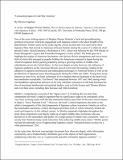| dc.contributor.author | Nagahara, Hiromu | |
| dc.date.accessioned | 2019-10-30T13:00:06Z | |
| dc.date.available | 2019-10-30T13:00:06Z | |
| dc.date.issued | 2019-03 | |
| dc.identifier.issn | 0145-2096 | |
| dc.identifier.issn | 1467-7709 | |
| dc.identifier.uri | https://hdl.handle.net/1721.1/122664 | |
| dc.description.abstract | One of the most striking aspects of Meghan Warner Mettler’s lucid and groundbreaking portrayal of postwar American engagement with Japanese culture is the sheer breadth of the phenomenon. Mettler starts out by analyzing the critical acclaim that was received by three Japanese films that arrived to American art house theaters during the course of a relatively short period of time: Akira Kurosawa’s Rashomon in 1951, which was followed by the 1954 release of Kenji Mizoguchi’s Ugetsu and Teinosuke Kinugawa’s Gates of Hell. The book goes on to highlight the origins of American fascination with ikebana flower arrangement and bonsai trees, both of which first emerged as popular hobbies for Americans stationed in Japan during the Allied Occupation before gaining popularity among a growing number of middle-class suburbanites across the United States. As the next chapter reveals, however, the influence of Japanese aesthetics on the American lifestyle proved even more far-reaching, leading to the adoption of Japanese architectural and landscaping techniques in American homes as well as the proliferation of Japanese home furnishing goods during the 1950s and 1960s. Turing from home interiors to inner lives, the book culminates in two chapters that are dedicated to the short-lived but nonetheless remarkable “Zen Boom” that transpired between 1957 and 1960, during which Zen Buddhism captured the attention of not only suburban consumers of self-help literature but also of prominent intellectuals and spiritual leaders, such as Erich Fromm and Thomas Merton, and even Beat icons, including Jack Kerouac and Allen Ginsburg. | en_US |
| dc.publisher | Oxford University Press | en_US |
| dc.relation.isversionof | https://academic.oup.com/dh/article/43/3/575/5381633 | en_US |
| dc.rights | Creative Commons Attribution-Noncommercial-Share Alike | en_US |
| dc.rights.uri | http://creativecommons.org/licenses/by-nc-sa/4.0/ | en_US |
| dc.source | Prof. Nagahara via Ece Turnator | en_US |
| dc.title | “Consuming Japan in Cold War America”. A review of Meghan Warner Mettler, How to Reach Japan by Subway: America’s Fascination with Japanese Culture, 1945-1965 (Lincoln, NE: University of Nebraska Press, 2018). 294 pp. $50.00 (hardcover). | en_US |
| dc.type | Article | en_US |
| dc.identifier.citation | Nagahara, Hiramu."Consuming Japan in Cold War America: A review of Meghan Warner Mettler, How to Reach Japan by Subway: America’s Fascination with Japanese Culture, 1945-1965 (Lincoln, NE: University of Nebraska Press, 2018). 294 pp. $50.00 (hardcover)." Diplomatic History 43, 3 (June 2019): 575–577 © 2019 The Author(s) | en_US |
| dc.contributor.department | Massachusetts Institute of Technology. Department of Humanities. History Section | en_US |
| dc.relation.journal | Diplomatic History | en_US |
| dc.eprint.version | Author's final manuscript | en_US |
| dc.type.uri | http://purl.org/eprint/type/JournalArticle | en_US |
| eprint.status | http://purl.org/eprint/status/PeerReviewed | en_US |
| dspace.date.submission | 2019-10-23T13:53:02Z | |
| mit.journal.volume | 43 | en_US |
| mit.journal.issue | 3 | en_US |
